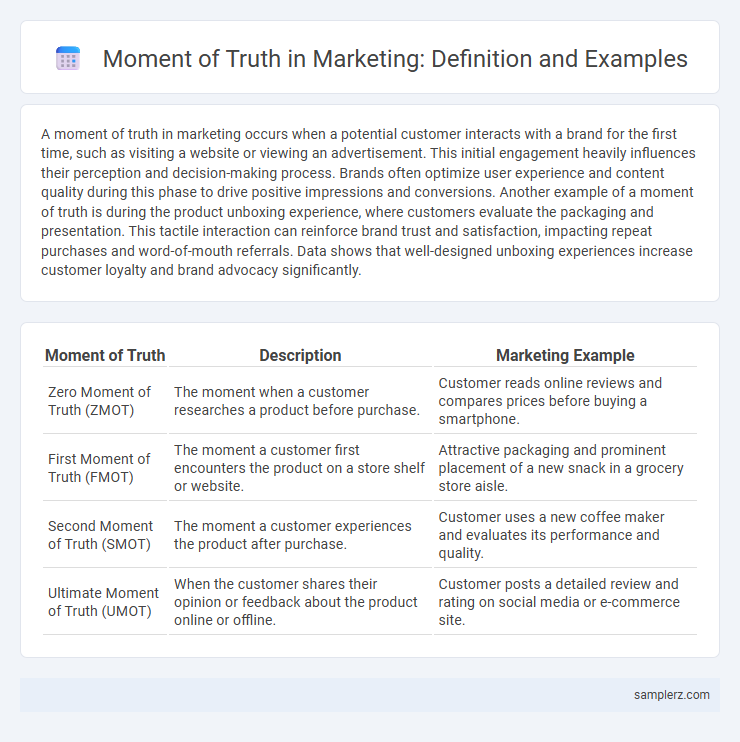A moment of truth in marketing occurs when a potential customer interacts with a brand for the first time, such as visiting a website or viewing an advertisement. This initial engagement heavily influences their perception and decision-making process. Brands often optimize user experience and content quality during this phase to drive positive impressions and conversions. Another example of a moment of truth is during the product unboxing experience, where customers evaluate the packaging and presentation. This tactile interaction can reinforce brand trust and satisfaction, impacting repeat purchases and word-of-mouth referrals. Data shows that well-designed unboxing experiences increase customer loyalty and brand advocacy significantly.
Table of Comparison
| Moment of Truth | Description | Marketing Example |
|---|---|---|
| Zero Moment of Truth (ZMOT) | The moment when a customer researches a product before purchase. | Customer reads online reviews and compares prices before buying a smartphone. |
| First Moment of Truth (FMOT) | The moment a customer first encounters the product on a store shelf or website. | Attractive packaging and prominent placement of a new snack in a grocery store aisle. |
| Second Moment of Truth (SMOT) | The moment a customer experiences the product after purchase. | Customer uses a new coffee maker and evaluates its performance and quality. |
| Ultimate Moment of Truth (UMOT) | When the customer shares their opinion or feedback about the product online or offline. | Customer posts a detailed review and rating on social media or e-commerce site. |
Defining the Moment of Truth in Marketing
The Moment of Truth in marketing occurs when a customer interacts with a brand, shaping their perception and influencing future buying decisions. This critical point can include the initial product discovery, the purchase experience, or post-purchase support, each impacting customer satisfaction and brand loyalty. Understanding and optimizing these moments enables marketers to create meaningful connections and drive long-term business growth.
First Impressions: The Zero Moment of Truth (ZMOT)
The Zero Moment of Truth (ZMOT) occurs when potential customers actively research a product online before making a purchase decision, making first impressions crucial in marketing. Brands optimize digital content, such as SEO-friendly product descriptions, customer reviews, and engaging videos, to capture attention during this critical decision-making phase. Successful ZMOT strategies increase brand visibility and influence consumer behavior by providing valuable, relevant information at the exact moment interest arises.
In-Store Encounters: The First Moment of Truth (FMOT)
The First Moment of Truth (FMOT) occurs when consumers interact with a product on the store shelf, making split-second decisions influenced by packaging, branding, and placement. Retailers optimize FMOT by employing eye-catching designs, strategic shelf positioning, and in-store promotions to capture consumer attention and drive purchases. Successful FMOT experiences significantly increase conversion rates and brand loyalty by delivering immediate value and emotional connection at the point of sale.
Product Usage: The Second Moment of Truth (SMOT)
The Second Moment of Truth (SMOT) occurs when consumers actively use a product, shaping their perception and satisfaction. Positive experiences during this phase drive brand loyalty and encourage word-of-mouth referrals, while negative experiences can lead to product returns or dissatisfaction. Marketers optimize SMOT by ensuring product quality, usability, and customer support to reinforce positive interactions and enhance lifetime value.
Post-Purchase Sharing: The Third Moment of Truth (TMOT)
Post-Purchase Sharing, known as the Third Moment of Truth (TMOT), occurs when customers share their experiences through reviews, social media, or word-of-mouth, significantly influencing brand perception and future sales. Brands that actively engage with user-generated content and foster community interaction enhance customer loyalty and attract new audiences. Leveraging TMOT as a strategic touchpoint increases authenticity and drives continuous marketing impact beyond the initial purchase.
Customer Testimonials as a Moment of Truth
Customer testimonials serve as a critical moment of truth in marketing by directly influencing potential buyers' trust and purchase decisions through authentic user experiences. These endorsements highlight product benefits, build brand credibility, and address concerns, effectively bridging the gap between initial interest and conversion. Leveraging video testimonials or detailed reviews significantly enhances engagement and drives higher conversion rates by showcasing real customer satisfaction.
Social Media Interactions Impacting Moments of Truth
Social media interactions serve as critical moments of truth where consumer perceptions and brand loyalty are shaped through real-time engagement and feedback. User comments, reviews, and influencer endorsements directly impact potential buyers' decision-making processes by providing authentic social proof. Brands that effectively monitor and respond to these interactions can transform casual interest into sustained customer relationships and advocacy.
Service Recovery: Turning Complaints into Moments of Truth
Service recovery in marketing transforms customer complaints into crucial moments of truth that can significantly enhance brand loyalty. Effective handling of service failures through swift response, empathetic communication, and personalized solutions often converts dissatisfied customers into brand advocates. Companies that excel in service recovery not only salvage unhappy customers but also differentiate themselves by showcasing commitment to customer satisfaction and continuous improvement.
Digital Touchpoints and the Evolving Moment of Truth
Digital touchpoints such as social media interactions, online reviews, and personalized email campaigns serve as critical moments of truth where consumers form or alter perceptions about a brand. The evolving moment of truth now includes real-time responses to customer feedback across digital platforms, influencing purchase decisions and brand loyalty instantly. Brands leveraging data analytics to optimize these digital interactions can significantly enhance customer engagement and conversion rates.
Real-World Case Studies: Brands Excelling at Moments of Truth
Apple exemplifies a moment of truth in marketing through its seamless product launch events, which build anticipation and deliver exceptional user experiences that reinforce brand loyalty. Amazon's one-click purchasing simplifies the buying process, transforming critical decision points into hassle-free transactions that boost conversion rates. Coca-Cola's personalized bottle campaigns connect emotionally with consumers at the purchase moment, turning simple sales into memorable brand interactions.

example of moment of truth in marketing Infographic
 samplerz.com
samplerz.com